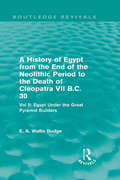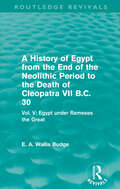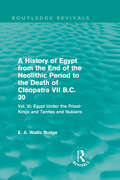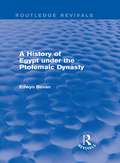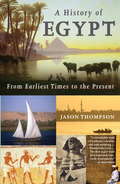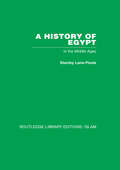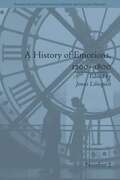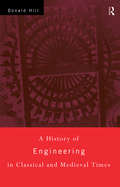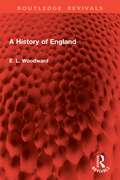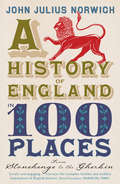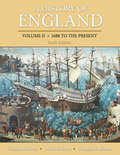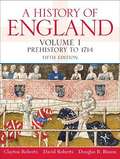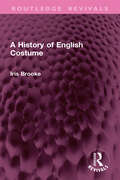- Table View
- List View
A History of Egypt from the End of the Neolithic Period to the Death of Cleopatra VII B.C. 30: Vol. I: Egypt in the Neolithic and Archaic Periods (Routledge Revivals)
by E. A. BudgeSir E. A. Wallis Budge (1857-1934) was Keeper of the British Museum’s department of oriental antiquities from 1894 until his retirement in 1924. Carrying out many missions to Egypt in search of ancient objects, Budge was hugely successful in collecting papyri, statues and other artefacts for the trustees of the British Museum: numbering into the thousands and of great cultural and historical significance. Budge published well over 100 monographs, which shaped the development of future scholarship and are still of great academic value today, dealing with subjects such as Egyptian religion, history and literature. This volume, first published in 1901 as part of the Egypt and Chaldaea series, is the first of eight volumes by Budge dealing with different periods in the history of Egypt. The narrative begins with an account of Egypt and her people in the latter part of the Neolithic period, and ends with the description of her conquest by the Romans under Caesar Octavianus, B.C. 30. Budge considers the great excavations of the nineteenth century in the first volume and, alongside detailed illustrations, provides a fascinating analysis of the dynastic kings.
A History of Egypt from the End of the Neolithic Period to the Death of Cleopatra VII B.C. 30: Vol. II: Egypt Under the Great Pyramid Builders (Routledge Revivals)
by E.A. Wallis BudgeSir E. A. Wallis Budge (1857-1934) was Keeper of the British Museum’s department of oriental antiquities from 1894 until his retirement in 1924. Carrying out many missions to Egypt in search of ancient objects, Budge was hugely successful in collecting papyri, statues and other artefacts for the trustees of the British Museum: numbering into the thousands and of great cultural and historical significance. Budge published well over 100 monographs, which shaped the development of future scholarship and are still of great academic value today, dealing with subjects such as Egyptian religion, history and literature. This volume, first published in 1902 as part of the Egypt and Chaldaea series, is the second of eight volumes by Budge dealing with different periods in the history of Egypt. The narrative ranges from the end of the 3rd Dynasty up to the close of the reign of Seānkh-ka-Rā, who was famous for the despatch of an expedition to Punt, and was the last king of the 6th Dynasty. This second volume deals with the Great Pyramid Builders of Egypt, and, alongside detailed illustrations, provides a fascinating analysis of the dynastic kings.
A History of Egypt from the End of the Neolithic Period to the Death of Cleopatra VII B.C. 30: Vol. III: Egypt Under the Amenemhāts and Hyksos (Routledge Revivals)
by E. A. BudgeSir E. A. Wallis Budge (1857-1934) was Keeper of the British Museum’s department of oriental antiquities from 1894 until his retirement in 1924. Carrying out many missions to Egypt in search of ancient objects, Budge was hugely successful in collecting papyri, statues and other artefacts for the trustees of the British Museum: numbering into the thousands and of great cultural and historical significance. Budge published well over 100 monographs, which shaped the development of future scholarship and are still of great academic value today, dealing with subjects such as Egyptian religion, history and literature. This volume, first published in 1902, is the third of eight volumes by Budge dealing with different periods in the history of Egypt. The narrative continues from the end of the reign of Seānkh-ka-Rā (c. 2500 B.C.), the last king of the XIth Dynasty, to the end of the reign of Thothmes II (c.1550 B.C.). Budge explores this rich and important period of Egyptian history in a classic work of great value to those interested in Egyptology and archaeology.
A History of Egypt from the End of the Neolithic Period to the Death of Cleopatra VII B.C. 30: Vol. IV: Egypt and Her Asiatic Empire (Routledge Revivals)
by E. A. BudgeSir E. A. Wallis Budge (1857-1934) was Keeper of the British Museum’s department of oriental antiquities from 1894 until his retirement in 1924. Carrying out many missions to Egypt in search of ancient objects, Budge was hugely successful in collecting papyri, statues and other artefacts for the trustees of the British Museum: numbering into the thousands and of great cultural and historical significance. Budge published well over 100 monographs, which shaped the development of future scholarship and are still of great academic value today, dealing with subjects such as Egyptian religion, history and literature. This volume, first published in 1902, is the fourth of eight volumes by Budge dealing with different periods in the history of Egypt. The narrative continues from the end of the reign of Thothmes II to the end of the rule of the XVIIIth Dynasty, 1550-1400 B.C. During these years the Egyptians established their empire in Palestine and Syria and began to consolidate their position on the world stage. This fascinating period is explored by Budge in a classic work of great value to those interested in Egyptology and archaeology.
A History of Egypt from the End of the Neolithic Period to the Death of Cleopatra VII B.C. 30: Vol. V: Egypt under Rameses the Great (Routledge Revivals)
by E. A. BudgeSir E. A. Wallis Budge (1857-1934) was Keeper of the British Museum’s department of oriental antiquities from 1894 until his retirement in 1924. Carrying out many missions to Egypt in search of ancient objects, Budge was hugely successful in collecting papyri, statues and other artefacts for the trustees of the British Museum: numbering into the thousands and of great cultural and historical significance. Budge published well over 100 monographs, which shaped the development of future scholarship and are still of great academic value today, dealing with subjects such as Egyptian religion, history and literature. This volume, first published in 1902, is the fifth of eight volumes by Budge dealing with different periods in the history of Egypt. The narrative begins with the reign of Rameses I, the first king of the XIXth Dynasty, and ends with the rule of Rameses XII. It covers the principal events which took place between the years 1400 and 1130 B.C., including the Hebrew exodus. Budge explores this rich and important period of Egyptian history in a classic work of great value to those interested in Egyptology and archaeology.
A History of Egypt from the End of the Neolithic Period to the Death of Cleopatra VII B.C. 30: Vol. VI: Egypt Under the Priest-Kings and Tanites and Nubians (Routledge Revivals)
by E. A. BudgeSir E. A. Wallis Budge (1857-1934) was Keeper of the British Museum’s department of oriental antiquities from 1894 until his retirement in 1924. Carrying out many missions to Egypt in search of ancient objects, Budge was hugely successful in collecting papyri, statues and other artefacts for the trustees of the British Museum: numbering into the thousands and of great cultural and historical significance. Budge published well over 100 monographs, which shaped the development of future scholarship and are still of great academic value today, dealing with subjects such as Egyptian religion, history and literature. This volume, first published in 1902, is the sixth of eight volumes by Budge dealing with different periods in the history of Egypt. The narrative begins with the reign of Nes-ba-Tettet, the first king of the XXIst Dynasty, and ends with the third king of the XXVIth Dynasty, Psammetichus II. Covering the years 1100-600 B.C., Budge analyses how Egypt changed shape under the rule of different kings, and witnessed both decline in and consolidation of power at varying points. This rich and important period of Egyptian history is explored in a classic work of great value to those interested in Egyptology and archaeology.
A History of Egypt from the End of the Neolithic Period to the Death of Cleopatra VII B.C. 30: Vol. VII: Egypt Under the Saites, Persians and Ptolemies (Routledge Revivals)
by E. A. BudgeSir E. A. Wallis Budge (1857-1934) was Keeper of the British Museum’s department of oriental antiquities from 1894 until his retirement in 1924. Carrying out many missions to Egypt in search of ancient objects, Budge was hugely successful in collecting papyri, statues and other artefacts for the trustees of the British Museum: numbering into the thousands and of great cultural and historical significance. Budge published well over 100 monographs, which shaped the development of future scholarship and are still of great academic value today, dealing with subjects such as Egyptian religion, history and literature. This volume, first published in 1902, is the seventh of eight volumes by Budge dealing with different periods in the history of Egypt. The narrative begins with the reign of Uah-ab-Rā, a king of the XXVIth Dynasty, and ends with that of Ptolemy IV. A period of increasing national prosperity, the influence of external influences can be seen during these years, which Budge argues paved the way for the advent of Christianity. This is a fascinating and important work, which is still of great value to those interested in Egyptology and archaeology.
A History of Egypt from the End of the Neolithic Period to the Death of Cleopatra VII B.C. 30: Vol. VIII: Egypt Under the Ptolemies and Cleopatra VII (Routledge Revivals)
by E. A. BudgeSir E. A. Wallis Budge (1857-1934) was Keeper of the British Museum’s department of oriental antiquities from 1894 until his retirement in 1924. Carrying out many missions to Egypt in search of ancient objects, Budge was hugely successful in collecting papyri, statues and other artefacts for the trustees of the British Museum: numbering into the thousands and of great cultural and historical significance. Budge published well over 100 monographs, which shaped the development of future scholarship and are still of great academic value today, dealing with subjects such as Egyptian religion, history and literature. This volume, first published in 1902, is the final volume of eight by Budge dealing with different periods in the history of Egypt. The narrative ranges from the end of the reign of Ptolemy IV, c. 210, to the death of Cleopatra VII in c.30 B.C. This is a fascinating and important work, which is still of great value to those interested in Egyptology and archaeology.
A History of Egypt under the Ptolemaic Dynasty (Routledge Revivals)
by Edwyn BevanFirst published in 1927, this title presents a well-regarded study of this intriguing and often over-looked period of Egyptian history, both for the general reader and the student of Hellenism.Edwyn Bevan describes his work as ‘an attempt to tell afresh the story of a great adventure, Greek rule in the land of the Pharaohs…which ends with the astounding episode of Cleopatra’. The result is a remarkable synthesis of historical scholarship, prose style and breadth of vision, which will still prove to be of value to Egypt enthusiasts and students of Egyptology.
A History of Egypt: From Earliest Times to the Present
by Jason ThompsonIn A History of Egypt, Jason Thompson has written the first one-volume work to encompass all 5,000 years of Egyptian history, highlighting the surprisingly strong connections between the ancient land of the Pharaohs and the modern-day Arab nation. No country's past can match Egypt's in antiquity, richness, and variety. However, it is rarely presented as a comprehensive panorama because scholars tend to divide it into distinct eras--prehistoric, pharaonic, Greco-Roman, Coptic, medieval Islamic, Ottoman, and modern--that are not often studied in relation to one another. In this daringly ambitious project, drawing on the most current scholarship as well as his own research, Thompson makes the case that few if any other countries have as many threads of continuity running through their entire historical experience. With its unprecedented scope and lively and readable style, A History of Egypt offers students, travelers, and general readers alike an engaging narrative of the extraordinarily long course of human history by the Nile. From the Trade Paperback edition.
A History of Egypt: In the Middle Ages
by Stanley Lane-PooleWhen originally published in 1901, this volume related for the first time the History of Egypt in the Middle Ages, from its conquest by the Saracens in 640 to its annexation by the Ottoman Turks in 1517 in a continuous narrative apart from the general history of the Muslim caliphate.
A History of Emotions, 1200–1800 (Studies for the International Society for Cultural History #2)
by Jonas LiliequistThe essays in this collection examine emotional responses to art and music, the role of emotions in contemporary notions of gender and sexuality and theoretical questions as to their use.
A History of Endometriosis
by Ronald BattThe early history of endometriosis is interwoven with the history of adenomyosis, since it was not until the mid nineteen-twenties that the two conditions were finally separated. A History of Endometriosis provides a detailed reconstruction of the progress made in identifying, describing and treating the condition we call today endometriosis.
A History of Energy: Northern Europe from the Stone Age to the Present Day
by Bent SorensenIn this seminal book, Bent Sørensen views human society as driven by the quest for, and control of, energy. From allowing our prehistoric ancestors to survive harsh northern European winters to more recent global energy security and climate concerns, the control and effective harnessing of energy sources has played a central role in human development. Using the written and archaeological record and, from earlier times, inferring the energy needs of humans through modeling of climatological conditions and other indirect parameters, Sørensen unwraps this previously little-explored field. Based on detailed studies of northern Europe – and in particular the case of Denmark – the focus moves from the stone age, through the development of agriculture and trade, migration and exploration, medieval society and the renaissance, into industrial times and present-day debates around the transition to low-carbon forms of energy supply. This riveting examination of a nascent field of study provides a new perspective for historians and those wishing to gain a deeper understanding of the background to present-day energy debates.
A History of Engineering in Classical and Medieval Times
by Donald HillIt is impossible to understand the cultures and achievements of the Greeks, Romans, Byzantines, and Arabs, without knowing something of their technology. Rome, for example, made advances in many areas which were subsequently lost and not regained for more than a millenium. This is a knowledgeable yet lucid account of the wonderful triumphs and the limitations of ancient and medieval engineering. This book systematically describes what is known about the evolution of irrigation works, dams, bridges, roads, building construction, water and wind power, automata, and clocks, with references to the social, geographical, and intellectual context.
A History of England (Routledge Revivals)
by Llewellyn WoodwardFirst Published in 1947, A History of England combines a concise record of events with an absorbing picture of England’s evolution in the political, social, economic, and cultural spheres. It brings important themes like Britain under the Romans; the Norman conquest; Edward I and the parliaments; the civil war; Oliver Cromwell and Puritan England; the revolution of 1688; England in the eighteenth and nineteenth century; the defeat of Napoleon; the early twentieth century and the first German war; Britain between the two wars; British foreign policy between 1919 to 1939 and the Second World War and after. This comprehensive volume is a must read for students of British history.
A History of England in 100 Places: From Stonehenge to the Gherkin
by John Julius NorwichFrom battlefield to sacred building, from castle to cottage, from the Bridgwater Canal to Blackpool Pier, historian John Julius Norwich tells the political, cultural, social, religious and economic story of England through one hundred key places you can still visit today. Part narrative history, part exploration of our national heritage, his wide-ranging selection of sites will stimulate, entertain, inform - and certainly provoke - a debate about the most significant moments in English history.
A History of England, Volume 1: Prehistory to 1714
by Clayton Roberts Douglas Bisson F David RobertsThis two-volume narrative of English history draws on the most up-to-date primary and secondary research, encouraging students to interpret the full range of England's social, economic, cultural, and political past. A History of England, Volume 1 (Prehistory to 1714), focuses on the most important developments in the history of England through the early 18th century. Topics include the Viking and Norman conquests of the 11th century, the creation of the monarchy, the Reformation, and the Glorious Revolution of 1688.
A History of England, Volume 1: Prehistory to 1714
by David Roberts Clayton Roberts Douglas R. BissonThe seventh edition of this two-volume narrative of English history draws on the most up-to-date primary and secondary research, encouraging students to interpret the full range of England's social, economic, cultural, and political past from its first inhabitants to the 2020s.A History of England, Volume 1: Prehistory to 1714 focuses on the key social, economic, cultural, environmental, intellectual, and political events and themes of English history up to the early eighteenth century. Topics include the Viking and Norman conquests of the eleventh century, the creation of the monarchy, the Reformation, and the Glorious Revolution of 1688. The text discusses events in Scotland, Wales, and Ireland as they affected developments in England. There is a new section dealing with the decline of belief in witchcraft.This book is essential introductory reading for students of the history of England and Britain.
A History of England, Volume 2: 1688 to the Present
by David Roberts Clayton Roberts Douglas BissonThe seventh edition of this two-volume narrative of English history draws on the most up-to-date primary and secondary research, encouraging students to interpret the full range of England's social, economic, cultural, and political past from its first inhabitants to the 2020s.A History of England, Volume 2: 1688 to the Present focuses on the key social, economic, cultural, environmental, intellectual, and political events and themes of English history since 1688. Topics include Britain's emergence as a great power in the eighteenth century, the American War for Independence, the Industrial Revolution, and the economic crisis of the 1970s. The text discusses events in Scotland, Wales, and Ireland as they affected developments in England. The second volume features an in-depth treatment of the origins and course of the First and Second World Wars and provides an updated analysis of developments since 2012, including an account of Britain’s withdrawal from the European Union; the resignations of David Cameron, Boris Johnson, and Liz Truss as prime minister; the selection of Rishi Sunak as the nation’s first British Asian prime minister; and a discussion of the 2015, 2017, and 2019 elections.This book is essential introductory reading for students of the history of England and Britain.
A History of England, Volume 2: 1688 to the present
by Clayton Roberts Douglas Bisson David F. RobertsA History of England, Volume 2 (1688 to the Present), focuses on the key events and themes of English history since 1688. Topics include Britain's emergence as a great power in the 18th century, the American War for Independence, the Industrial Revolution, and the economic crisis of the 1970s.
A History of England: From the Landing of Julius Caesar to the Present Day
by H. O. Arnold-ForsterFrom The Landing of Julius Caesar To The Present Day (Early 1900's). H.O. Arnold-Forster’s history of England starting with the landing of the Romans on the shores of the British Isles through the early 20th century (the author’s “present day.”). The chapters cover the major rulers, events, science, art, literature, and every day life during these periods in England and beyond. <p><p>First published in 1907, this edition is derived from the original book with over 300 black and white illustrations. As always, this edition is complete and unabridged.
A History of England: Volume 1 (5th Edition)
by David Roberts Clayton Roberts Douglas R. BissonFor two-semester, junior/senior-level courses in the History of England. Volume I may be used for a one-semester course in the History of England to 1714. This two-volume broad, narrative account of English history-from the first settlers in the Paleolithic Age to the present day-draws on the most up-to-date primary and secondary research to illuminate the full range of England's social, economic, cultural, and political past, and focuses on how and why events occurred.
A History of English Costume (Routledge Revivals)
by Iris BrookeOriginally published in 1937 and reprinted as a fourth edition in paperback in 1979, this is a history of dress in England from the Norman Conquest to the mid-20th century. Despite being an excellent resource for the student or designer, this book also provides a wealth of material for the social historian. Indeed, the author argues that costume is important because it is custom, and custom and habit have helped to shape history just as much as political machinations and geographical discoveries.
A History of English Field Names (Approaches to Local History)
by John FieldField names are not only interesting in themselves, but also a rich source of information about the communities originating them. The earliest recorded names often describe only the location or nature of the land, but changes in language, technology, social organisation, land ownership and even religious and political thinking have all contributed to a surprisingly complex picture today. A pioneering history.

